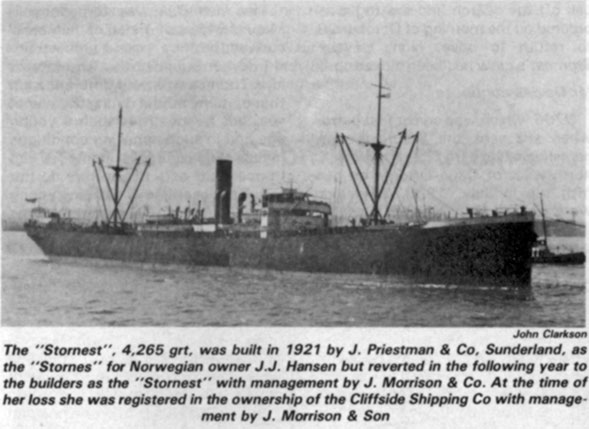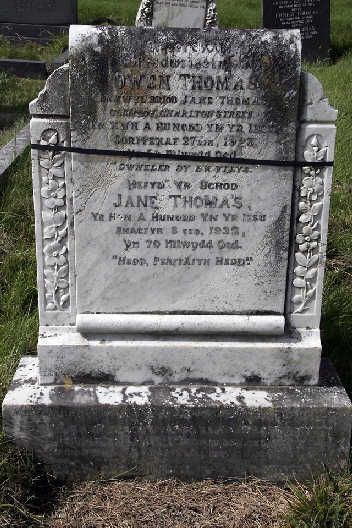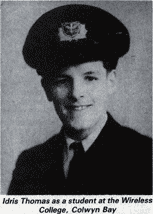|
|
 |
||||||||||||||||||
|
An article from Sea Breezes “The Magazine of Ships and the Sea” In Memory of Idris Thomas, Lost a Introduced by Sid Davies Some five years ago my brother noticed that the war memorial at Penmaenmawr, North Wales, did not carry the name of Idris Thomas. It was known that Idris had been lost on his first trip to sea in 1942 and the omission probably lay in the fact that his family moved to Wallasey at about that time. Having from time to time been struck by the sadness of the loss of such a young life - he was 18 - I became interested in finding out about the loss of his ship, the Stornest. A small paragraph in Sea Breezes brought a lot of information and advice concerning further sources and I now have a thickish file of letters from some very interesting people. Idris Thomas had completed a course at the Wireless College, Colwyn Bay, and was sent to join the Stornest at Swansea where she was loading coal for Boston, USA. With a crew of 29 and 10 gunners she sailed from Milford Haven and the graphic details of her subsequent fate are given in the following report from the Ministry of Defence, Naval Staff Duties Section (British Crown copyright 1992/MOD reproduced with the permission of the Controller of Her Britannic Majesty’s Stationery Office): “The Cliffside Shipping Co steamer Stornest 4,265 grt, sailed from Milford Haven with seven other ships on the afternoon of October 2, 1942, to rendezvous in the northern Irish Sea with convoy ONS 136, which was due to leave Liverpool on October 3. The Stornest, which was bound for Boston, Mass, with a cargo of coal, joined ONS 136 on October 4 and took up station in position 52, which was in the centre of the convoy immediately astern of the commodore’s ship. The convoy then proceeded into the Atlantic through the North Channel. “Virtually continuously bad weather was encountered in the North Atlantic, gale-force winds making it impossible for the escorts to keep the convoy together throughout the whole of the crossing. Ships were repeatedly falling astern and on October 11 the Stornest was one of a number reported by the Senior Officer of the escort to be straggling. “Just under 36 hours later, at 2202 (all times quoted are in GMT) on October 12, the ship was sighted some 130 miles south-east of the convoy by U706, under the command of Kapitanleutnant Alexander von Zitzewitz. She was then, according to von Zitzewitz, steering 250 deg at an estimated eight knots. “U706 thereupon shaped course to haul ahead of the steamer to attain an attacking position, but the U-boat made slow progress owing to the visibility, which varied between three and four miles but dropped to one mile in the frequent rain showers. The U-boat’s speed of advance was further affected when, at 2316, the port thrust-block began to run hot and she was forced to proceed on only one engine. “It was thus not until 0138 on October 13 that U706, having reached a suitable attacking position, ran in and fired a spread salvo of two electrically-driven torpedoes from the bow tubes at a range of 900m. Both torpedoes appeared to run normally but no explosion ensued. The U-boat’s crew, convinced they were on target, suspected pistol failure. “U706 thus ran in again and at 0205 a second spread salvo was fired from the other two bow tubes at a range of 800m. This time the attack was successful, the left-hand torpedo striking the ship abreast the foremast after running for 34 seconds. There was a large explosion plume, the Stornest fired of three red rockets and von Zitzewitz could see the flashing of lights on the upper deck. “The Stornest reduced speed and commenced transmission of a distress signal, giving her position as 57deg 25’N, 27deg 42’W, which von Zitzewitz tried unsuccessfully to jam. “Despite being badly holed in No.1 hold the Stornest remained afloat on an even keel. Von Zitzewitz thus decided to finish her off with another torpedo, which was fired at 0234 from close range from the stern tube. Inexplicably the torpedo missed. U706 then having emptied all five torpedo tubes withdrew to reload one bow torpedo tube for another attempt. “Reloading was completed an hour or so later and U706 ran in again, firing at 0403 at a stopped and drifting target. Once more, however, there was no result, which caused von Zitzewitz to wonder if the ship was fitted with torpedo nets. If not, he considered the only explanation was deviation of the torpedo from its track owing to heavy seas, despite its having been given a depth-setting of as much as 4m. “Von Zitzewitz reckoned he still had time to reload another tube before daybreak but had to dive to carry out the operation because of an increasingly high sea. “U707 resurfaced at 0533. There was then no sign of the torpedoed vessel and, after a search had failed to find anything other than an apparently empty lifeboat drifting northwards from the steamer’s last know position, von Zitzewitz called off the search at 0714 on the assumption that the ship had sunk. U706 then withdrew from the scene, setting course to regain her position in the patrol line. “In reality the Stornest had not gone down and was actually still afloat some 24 hours after the attack. By 0429 on October 14, however, her situation had clearly become critical for at that time she reported from position 54deg 34’N, 26deg 39’W, that she was listing heavily, water was agining rapidly and she was unable to hold out much longer. “At 0444 the Irish Oak, independently bound for the United States from Ireland, responded to the Stornest’s distress signals, informing the stricken ship that she was about 90 miles away in position 53deg 45’N 24deg 47’W, and, if any used, would come along. The Stornest requested her to do so and inquired if she had direction finding gear. “A few minutes later, at 0450, the Stornest reported to the Irish Oak that the ship was being abandoned but that the Irish ship should keep coming. “To a further inquiry from the Irish Oak the Stornest confirmed that she had rafts (she had earlier reported the loss of her lifeboats which, on being lowered, had probably either been swamped or drifted away from the ship in the heavy weather, which ai a possible explanation for the empty boat seen by U706). “In addition to the Irish Oak, the rescue tug Adherent in company with the anti-submarine trawler Drangey, which had been dispatched on Admiralty orders on October 13, were proceeding to the Stornest’s assistance. Two corvettes had also been ordered to detach from the following convoy, ONS 137, and search for survivors. “At 1357 on October 14 the Irish Oak signalled that owing to heavy seas and a westerly gale she had abandoned the rescue. “The tug and trawler arrived in the Stornest’s last known position early on October 17 but their search was without result. The weather then turned foggy but they were nevertheless ordered on October 18 to continue searching. “On the afternoon of October 19, however, the Admiralty decided in the light of continuing bad weather to call of the search and the tug was ordered on the morning of October 29 to return to base. None of the Stornest’s crew had been picked up.” Mr Davies continues... U706, which was on her first patrol when she sank the Stornest, was herself sunk by a US Liberator aircraft north-west of Cape Ortegal on her fifth trip in July, 1943. Survivors were picked up by HMS Waveney. The Irish Oak was torpedoed in May, 1943, but most of her crew survived. I do not suppose that the fate of Idris Thomas was very different from that of many others during the war at sea, but his death at such a young age and in such appalling conditions makes sad reading. As memories dim I hope that, as a nation, we do not forget the sacrifice of so many young lives. |
||||||||||||||||||
 |
||||||||||||||||||
|
In August 2009 when looking for war graves in Llandudno Great Orme Cemetery for The War Grave Photographic Project (www.twgpp.org.uk) I (Pete Robinson) came across the grave pictured below. |
||||||||||||||||||
 |
||||||||||||||||||
|
The section of interest is the bottom of the stone pictured below |
||||||||||||||||||
 |
||||||||||||||||||
|
This in Welsh and is difficult to read but it basically says He is listed on the Commonwealth War Graves Commission website www.cwgc.org.uk and is commemorated at Tower Hill Memorial, London. |
||||||||||||||||||
|
|
||||||||||||||||||
 t Sea
t Sea